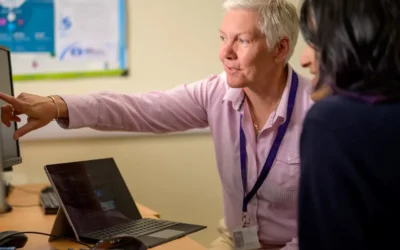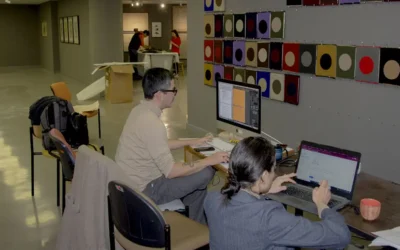Museum Forecast 2024

Rachael Cristine Woody
Welcome to the fifth year of forecasts for the museum field! As the years continue to tick on by it seems that more and more changes are coming to one of the most stationary fields in the world.
What is even more interesting is that these changes are driven by technology as well as evolving ethics on what is acceptable best practice. With this in mind, the three forecasts I am about to present to you are an interesting mashup of where we are and where we’re headed. Museum digital programs and the adoption of Artificial Intelligence (AI) tools portend and explosion of innovation in this space—but only if museums can right-size their annual budget allocations. While digital innovation may bring a revival of spirit, will it be too late for the thousands of us destined to leave the field because of burnout? Let’s get into it.
As a recap, here are the past four years of forecasts:
Museum Forecast 2023
- No more working for “free”; the Illegalization of unpaid internships
- Repatriation is no longer optional
- The evolution of the Collection Development policy
Museum Forecast 2022:
- No More Half-Measures When It Comes to Offering Accessibility
- The Continued and Accelerated Elimination of Museum “Entry-Level” Jobs
- A Digital Boom
Museum Forecast 2021:
- Museums Will Close
- Collections Accessioning and Deaccessioning
- Digital Collections are a Higher Priority
Museum Forecast 2020:
- DEAI embedded into museums and driving programmatic change
- Grant Funding, modest budgets, funding threatened, and incredibly competitive
- Ethical Labor Practices requiring salary transparency, institutions lack financial health
Museum Forecast 2024
As I look to 2024, here are the three main items I foresee as hallmarks of the year ahead:
- Digital programs will sink or swim in the fight for adequate resources to continue running.
- Artificial Intelligence (AI) will emerge as a major tool for empathy generation at museums.
- Pervasive burnout will not be addressed in a meaningful way and staff will need to shift into survival-mode for the sake of their health.
Forecast: Digital Programs Sink or Swim in the Fight for Adequate Resources
Remember how in 2020 all we could “do” was digital? Working with collections virtually and publishing things online as fast as we could? Due to closures, resources were unexpectedly available to fuel remarkable growth and output for museum digital programs. While I have always advocated that digital is an important and permanent program for museums to resource appropriately—this should’ve become a common understanding among museum leadership as a result of the COVID-19 pandemic.
However, things are now “back to normal” which means exhibitions are in full swing and many are in overdrive as a pandemic’s worth of traveling shows and planned programming attempt to catch up. For many museums, this means funding has swung back toward exhibitions and in-person programming, leaving digital programs struggling to continue a high-level of output without the resources required to do so. As the majority of museums have yet to recognize their digital work as a fully-fledged program that requires a budget line (not even after the pandemic closures), no financial resources have been set aside to continue this work. This is then compounded by exhibitions reaching full capacity and, in many cases, over-capacity—therefore costing more money.
This increase in exhibitions work paired with the continued pressure to digitize and place collection content online at the higher rate, many museum staff are suffering from the inability to “do it all”. There’s not enough money, there’s not enough equipment and other tools, and there aren’t enough staff. A reprioritization or rebalancing needs to occur, paired with a permanent adjustment of the budget to reflect a robust (or at least functioning) digital program. Ultimately, the budget needs to reflect how the way museums have traditionally “done business” has changed.
My forecast is that museums will reach a “sink or swim” point with leadership regarding resource allocation to digital programs. The options being:
- Museum leadership reexamines and adjusts annual funding to account for the consistent funding need for a Digital Programs department (in whatever form that looks like); or
- The unofficial digital aspects of the museum continue to shrink to a size that matches the current resource allocation.
Essentially, there will either be a reprioritization of the budget OR a rebalancing of priorities that shifts digital production downward.
Forecast: Artificial Intelligence as Empathy Generators in Museums
If you’ve followed the evolution of AI in these last few years you may be familiar with the many conversations around artificial empathy and the ultimate question of whether machines can empathize. There’s also the reverse effect—perhaps best seen in fiction—where artificial life inspires empathy from humans, for good or for ill. One of my all-time favorite movies is I, Robot with the artificial life known as Sonny. What stays with me is the profound empathy Sonny and, indeed, all the discarded robots were able to evoke in me.
The discussion surrounding AI, artificial empathy, and humanity’s capacity to feel empathy of artificial beings is endlessly fascinating, but to bring it back to museums, we have a fourth application of empathy to explore. During The Future of Museums Summit by AAM’s The Center for the Future of Museums, there was a session titled Putting AI to Work in the Museum with panelist Beth Harrison, Director of Digital Experiences at the The Dalí. Using images, letters, and other text about Salvador Dalí, The Dalí used AI to create a dynamic and interactable Dalí via a full-sized screen. While the interaction itself is of an amazing quality and I love how archival materials informed the machine learning; the ways in which empathy was inspired is the most remarkable.
When you first approach Dalí you see him in the distance (in the screen) with a spotlight on him painting. Then, his body stiffens and after a moment he turns his head because he “felt” your presence. His face then transforms to delight at seeing you and quickly gets up and walks over to you (the front of the screen). You can ask him any question you want and he’ll answer you based on the thousands of pieces of data he has access to. This makes his responses feel genuine and natural, not robotic or pre-programmed at all. While Dalí’s known eccentricities can be charming, what seals the deal is the end of the interaction. Toward the end of your conversation with Dalí, he asks you if he can take a selfie with you. If you agree, he holds up a smart phone on his side (in the screen) and you all pose together. This image is then texted to you as a memento. You may think this modern action pokes a hole in the historical accuracy of it all, but its end effect is endearing and inspires a sense of connectedness.
My forecast is that museums will increasingly experiment with bringing AI into their programs and galleries (in-person and online), and will be a topic of learning which will dominate these next few years of innovation in the museum field.
Given the mass amount of information museums naturally keep, this type of machine learning and the creation of artificial but empathetic peoples can be used by the museums to help cultivate empathy in their attendees. This is not a stretch as museums are already known centers for empathy generation. Museums as empathy cultivators made it into AAM’s 2016 TrendsWatch report, and I have written on the subject previously in 2018. So, this premise of using AI for empathy generation in museums builds upon an established foundation of empathy deployment within a museum setting. The game changer here is using AI as an empathy tool.
Forecast: Pervasive Burnout Remains Unaddressed in Any Meaningful Way
Many of us joined the museum field because it was our “dream job”, only to realize that the working conditions are a nightmare. And it doesn’t take a research study to figure out why (though they do exist). Both the oft-cited 2022 study by Museums Moving Forward and a scroll through countless posts on the subreddit r/museumpros will tell you that newer professionals and mid-careers are leaving the field due to bad pay and toxic work environments. When you add the upheaval of the last few years to these reasons, it’s easy to see why many are continuing to leave the field entirely. The rot is pervasive and entrenched into the foundations of each museum and professional organization which means that it’s going to take audacious actions at each level in order to inact permanent changes for the better, and that’s going to take a significant amount of time and energy from a field of people already running on fumes.
My forecast is that burnout and the issues that contribute towards it will continue to gain awareness within the field. However, until there’s meaningful change enacted by leadership levels—at the museum and at the professional organization-levels—individual’s mental health will continue to suffer, and hundreds will leave the field. Unfortunately, I think this will be another year of continued struggle, burnout, and field atrophy. But it doesn’t mean we can’t make some progress towards a healthier field.
What needs to come next is action from the leadership levels toward meaningful changes for the better. This requires leadership to:
- Know the issues exist;
- Care that the issues exist and wish to address them;
- Have the knowledge and tools to address the issues; and
- Have the time, resources, and backing to do so.
So, where does leadership acquire some of these needed resources? This is an area where I’d like to see professional organizations such as American Alliance of Museums, Association of Art Museum Directors, etc., take a leading role in raising awareness, offering leadership the knowledge and tools needed to make meaningful change at the museum-level.
As for the individual, you have taken on enough. If you’re in burnout mode, chances are that you’ve tried to “do all the things”. You took it upon yourself to acquire resources, you’ve put in unpaid overtime, you’ve used your own money, and you’ve advocated your heart out. It’s now time for deep rest, a deaccessioning of activities to bring you back down to a realistic workload, and a plan for how you can keep yourself healthy—whether that means changes to how you show up at your museum, or leaving the field all together.
Conclusion
There are a lot of possibilities ahead of us in 2024. We have the opportunity individually and as a field to make great strides in terms of digital programming and AI. A lot of responsibility rests on leadership, and we hope that they’re paying attention. However, we also have the agency to determine how we want to show up (or not) in our work.

Rachael Cristine Woody
Rachael Woody advises on museum strategies, digital museums, collections management, and grant writing for a wide variety of clients. She has authored several titles published by Lucidea Press, including Museum Digital Projects and You. Where to Begin? Rachael is a regular contributor to the Think Clearly blog and a popular presenter.
Never miss another post. Subscribe today!
Similar Posts
How to Incorporate Interns in Museum CMS Projects: Data Cleanup and Refinement
A museum expert details how interns can be successfully included in museum CMS projects at the data cleanup and refinement stage.
How to Incorporate Interns in Museum CMS Projects: Data Creation
A museum expert details how interns can be successfully included in museum CMS projects at the data creation stage.
How to Incorporate Interns in Museum CMS Projects: Data Capture
A museum expert highlights how interns can be included in museum CMS projects at the data capture stage
How to Incorporate Interns in Museum CMS Projects
A museum expert highlights how interns can be included in museum CMS projects with three project ideas.
Hosting service
Enjoy all of the benefits of your Lucidea solution with secure, reliable, stress free hosting
Programs & incentives
No matter your size or budget, we’ve got you covered, today and tomorrow




Leave a Comment
Comments are reviewed and must adhere to our comments policy.
0 Comments